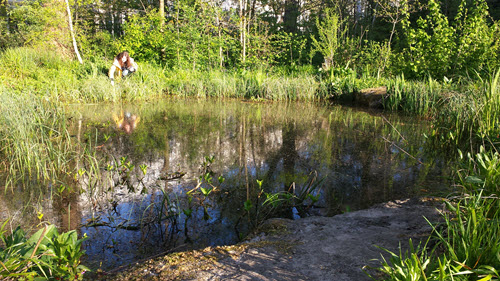Over the past few months you have heard quite a bit in the NBN eNews about the Identification Trainers for the Future project, but now we’re handing over the reins to our trainees to continue to update you with their progress and give them the chance to introduce themselves to you. Don’t forget you can always find out more about our project on our webpage, but for this month I will hand you over to Sally.
Steph West – Identification Trainers for the Future Project Manager

Over the past few weeks I’ve felt a little like Dorothy. Except for a few things, of course, including the lack of flying monkeys and impromptu outbreak into song. What I’m trying to describe is just how extraordinary it is to start working at the Natural History Museum. Everything’s become a bit Technicolour.
I’m Sally, one of the aspiring naturalists that have found themselves on the Identification Trainers for the Future traineeship. Based at the Natural History Museum, funded by the Heritage Lottery Fund and working in partnership with the National Biodiversity Network Trust and Field Studies Council, it is a beautifully crafted programme which aims to address the troubling disappearance of skills in field biology.
During the first part of the traineeship, the other trainees and I have been absorbed in the Museum, its vast collections and its history. I like how even the building itself represents centuries of scientific study, built tall with hidden plants and animals lurking in each wall, pillar and ceiling. For me, working within the Museum constantly reinforces our current place in the study of natural history, and the importance of bridging the growing gap in ecological skills. As part of the traineeship we are set to take part in several identification workshops over the next year, with bryophytes and lichens first up! I definitely don’t want go home.
Like most biologists, my curiosity for the natural world began at a young age with an unhealthy obsession (mine being elephants). This eventually led to a degree in Zoology, at the University of Sheffield, and a Masters year experimenting on some unfortunate fruit flies. After graduating I became increasingly involved in monitoring local biodiversity. I volunteered regularly on surveys – hunting for water vole latrines and tracking edible dormice. I took courses to build my identification skills, volunteered in my local museum and began my role as a Meadow Champion, part of the ‘Save our Magnificent Meadows’ Campaign’.
Before starting the traineeship I was Young Facilitator for the National Council for Voluntary Youth Services, working alongside partner organisation The Conservation Volunteers on environmental action projects in Kent. I supported weekly sessions of school groups, helping them to create wildlife friendly habitats in their school grounds, such as bug hotels, bird hides and wildflower meadows! It was an incredible experience working in wildlife education, and I’m keen to develop my teaching skills further, a key element of our traineeship. Over the next few months, we trainees will be starting work placements with the Field Studies Council and helping with the Museum’s Decoding NAture school residentials – for which we have designed a honeybee themed foraging activity! We have also been getting involved in the Museum’s Citizen Science projects including the Microverse, Big Seaweed Search and Orchid Observers survey. Although I’m really looking forward to improving my understanding of UK biodiversity during the traineeship, I’m particularly excited about developing creative new ways to engage others in identification!
Sally Hyslop, Identification Trainers for the Future Trainee
